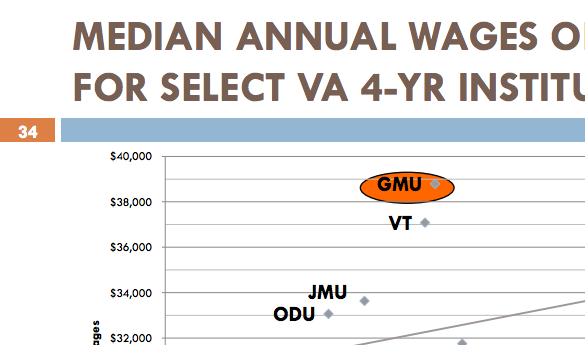Editor’s Blog: Mason’s funding problem in one question
At a regularly held budget forum on Oct. 10, two senior university officials painted an optimistic picture of the future of Mason’s finances, but emphasized that many challenges remain.
Provost Peter Stearns and Senior Vice President JJ Davis, presented a number of data sets revealing little support Mason receives as a public university. For example, out of Virginia’s six doctoral institutions, Mason receives the lowest per-FTE (full time equivalent) student funding. At the same time, the university spends 62 percent that of its peer institutions.
And Mason certainly isn’t alone. Public higher education has taken a hit across the country, and especially so in Virginia.
According to a recent state report, Virginia’s 15 public institutions received, on average, 15 percent of their total revenue from state appropriations in 2011, down from 27 percent in 1991. To make up for lost appropriations, Mason has looked to alternative sources of revenue, such as higher tuition rates and fees.
“Our in-state and state support tuition doesn’t cover the true costs,” Davis said. “There’s not a lot of margin to grow our out-of-state tuition.”
Even as the cost of higher education is shifted from the state to students, Stearns and Davis emphasized that Mason stacked up well compared to other public schools.
One metric that received positive responses from the audience compared the cost of select four-year institutions to the median annual wages of their graduates. Out of the institutions that were included in the graph, Mason’s graduates received the highest annual wage, while still being the fifth least expensive.
“Outcome measurement is going to become increasingly important,” Stearns said, adding that Mason looks at a number of metrics to measure its performance. “We are keenly aware that this is not the only way to measure educational outcomes.”
In fact, Davis acknowledged that Mason’s performance measures are so great, that they may be a liability when asking state officials for additional funding.
“We’ve been wildly successful with doing more with less…why can’t we just keep doing it?” Davis said; emphasizing that Mason still needed more support to maintain or enhance the quality of its education.
“We need investments in Mason,” Davis said. “We know that there are parts of our organization that are too lean. It is a very hard argument to make.”

